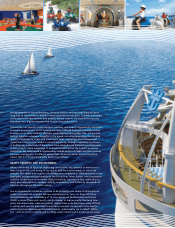Royal Caribbean Cruise Lines 2008 Annual Report Download - page 19
Download and view the complete annual report
Please find page 19 of the 2008 Royal Caribbean Cruise Lines annual report below. You can navigate through the pages in the report by either clicking on the pages listed below, or by using the keyword search tool below to find specific information within the annual report.
Royal Caribbean Cruises Ltd. 3
PART I
The following table details the growth in the global and North American cruise markets in terms of cruise passengers and estimated weighted-
average berths over the past five years:
Weighted-Average
Weighted-Average North American Supply of Berths
Global Cruise Supply of Berths Cruise Marketed in
Year Passengers
(1) Marketed Globally
(1) Passengers
(2) North America
(1)
2004 13,757,000 265,000 9,108,000 207,000
2005 14,818,000 282,000 9,909,000 216,000
2006 15,309,000 299,000 10,080,000 227,000
2007 16,586,000 323,000 10,330,000 242,000
2008 17,184,000 345,000 10,815,000 254,000
(1) Source: Our estimates.
(2) Source: Cruise Line International Association based on cruise passengers carried for at least two consecutive nights.
In an effort to penetrate untapped markets and diversify our customer
base, we have redeployed some of the ships in our Royal Caribbean
International and Celebrity Cruises brands from the North American
market to Europe, Latin America and Asia. This redeployment has
contributed to an increase in the growth of our global cruise brands
outside of the North American market.
Although the global and North American cruise markets have grown
steadily over the past several years, the recent weakening of the United
States and other economies has significantly deteriorated consumer
confidence and discretionary spending. This has caused a global drop in
demand for cruises and a resulting drop in cruise prices. The long-term
impact of these conditions on the continued growth of the cruise mar-
ket will depend on the depth and duration of this worldwide economic
downturn. In addition, the projected increase in capacity within the cruise
industry from new cruise ships currently on order could produce addi-
tional pricing pressures within the industry. See Item 1A. Risk Factors.
We compete with a number of cruise lines; however, our principal
competitors are Carnival Corporation & plc, which owns, among
others, Aida Cruises, Carnival Cruise Lines, Costa Cruises, Cunard
Line, Holland America Line, P&O Cruises and Princess Cruises and has
a joint venture with Orizonia Corporation under which they operate
Iberocruceros; Disney Cruise Line; MSC Cruises; Norwegian Cruise Line
and Oceania Cruises. Cruise lines compete with other vacation alter-
natives such as land-based resort hotels and sightseeing destinations
for consumers’ leisure time. Demand for such activities is influenced
by political and general economic conditions. Companies within the
vacation market are dependent on consumer discretionary spending.
Although vacation spending is likely to be curtailed significantly in the
midst of the current worldwide economic downturn, we believe that
cruising is perceived by consumers as a good value when compared
to other vacation alternatives.
Our ships operate worldwide and have itineraries that call on destina-
tions in Alaska, Asia, Australia, the Bahamas, Bermuda, California,
Canada, the Caribbean, Europe, the Galapagos Islands, Hawaii, Mexico,
New England, New Zealand, the Panama Canal and South America.
OPERATING STRATEGIES
Our principal operating strategies are to:
s manage the efficiency of our operating expenditures and preserve
cash and liquidity during the current worldwide economic downturn,
s increase the awareness and market penetration of our brands,
s expand our fleet with the new state-of-the-art cruise ships currently
on order,
s expand into new markets and itineraries,
s continue to expand and diversify our passenger mix through passen-
ger sourcing outside North America,
s protect the health, safety and security of our passengers and
employees and protect the environment in which our vessels
and organization operate,
s utilize sophisticated revenue management capabilities to optimize
revenue based on demand for our products,
s further improve our technological capabilities, and
s maintain strong relationships with travel agencies, the principal indus-
try distribution channel, while offering direct access for consumers.
Manage Operating Expenditures and Preserve Cash and Liquidity
During the current worldwide economic downturn we are focused on
maximizing the efficiency of our operating expenditures and preserving
cash and liquidity. During 2008, we announced the reduction in our
workforce of approximately 400 shoreside positions and implemented
a number of cost-saving initiatives in an effort to reduce our operating
costs. To preserve liquidity, we have discontinued our quarterly dividend
commencing in the fourth quarter of 2008, curtailed our non-shipbuild
capital expenditures, and currently do not have plans to place further
newbuild orders. We believe these strategies will enhance our ability to
fund our capital spending obligations and improve our balance sheet.
























